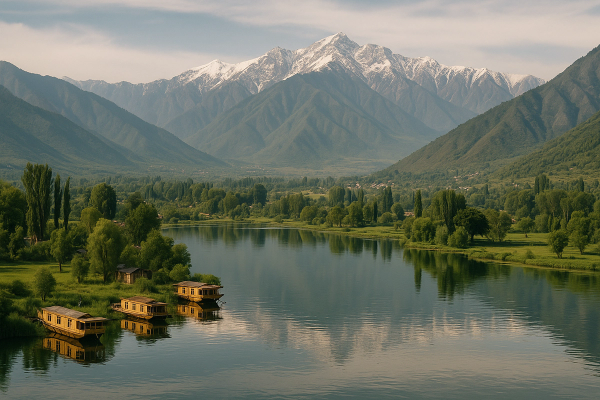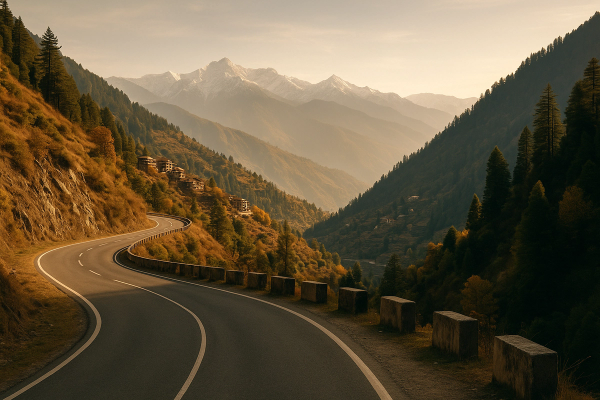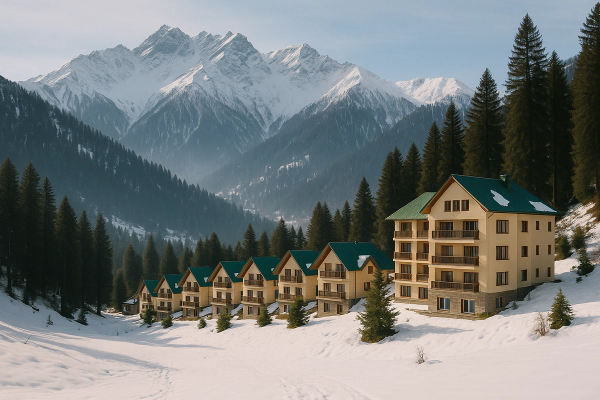Solo Backpacking India: Your Epic Adventure Starts Here!#
Okay, so picture this: you, a backpack, and the vast, vibrant, and utterly captivating country that is India. Sounds intimidating? Maybe a little. But trust me, embarking on a solo backpacking trip through India is one of the most transformative experiences you can have. I still remember landing in Delhi for the first time, a bit wide-eyed and utterly clueless. Honestly, I kinda winged it, armed with a guidebook and a whole lot of curiosity. Fast forward a few weeks, and I was trekking through the Himalayas, haggling for spices in a bustling market, and making friends with people from all over the world. India, my friends, is a whirlwind of sensory overload, spiritual awakening, and unforgettable moments. And, I’m here to tell you how you can make it your own epic adventure, whether you’re from the US, Europe, or anywhere in between.¶
India: A Quick Overview for the Uninitiated#
India… where do you even begin? It's a land of breathtaking diversity, from the snow-capped peaks of the Himalayas to the tropical beaches of Goa. It's a country steeped in history, with ancient temples, magnificent forts, and bustling cities that have been around for centuries. The culture is rich and varied, with a kaleidoscope of languages, religions, and traditions. I mean, you could spend years just exploring different parts of the country. And let’s be honest, it can also be a bit overwhelming at first. But that’s part of the charm, right? India will challenge you, surprise you, and probably make you laugh a lot. It's known for its vibrant colors, incredible food (seriously, get ready for a flavor explosion!), and the warmth of its people. People often think of India as chaotic, and yeah, there's a certain level of organized chaos, for sure. But don't let that scare you. Embrace the adventure, and you'll discover a country that will stay with you long after you've left.¶
When to Go: Timing Your Indian Adventure#
Choosing the right time to visit India can make or break your trip. The weather is a huge factor, and it varies significantly depending on the region. Generally, the best time to visit is during the cooler, drier months, but let's break it down.¶
The Ideal Time: October to March#
This is peak season, and for good reason. The weather is generally pleasant across most of the country. Think sunshine, comfortable temperatures, and low humidity. Perfect for exploring ancient temples, hiking in the mountains, or relaxing on the beaches. The only downside? Expect higher prices and more crowds, especially in popular destinations.¶
- Pro: Perfect weather conditions for all activities.
- Con: Increased prices and tourist crowds, especially during the holiday season (December-January).
The Shoulder Seasons: April and September#
April is hot, so be prepared. September is hot and you'll get hit with rain - but if you are okay with that you should be able to get some deals and more space. April is super hot in most places. September is when the monsoon season is ending in many regions, so you might get a mix of sunshine and rain, but the crowds are thinner, and the prices are a little more forgiving. Plus, you might catch some festivals.¶
| Season | Weather | Crowds | Costs | Best For |
|---|---|---|---|---|
| October - March | Cool, dry, sunny (varies by region) | High | High | General sightseeing, outdoor activities |
| April | Hot and dry (very hot in many regions) | Moderate | Moderate | Budget travelers who can handle the heat, last chance before monsoon |
| May - August | Hot, humid, monsoon season (varies by region) | Low | Low | Visiting specific areas unaffected by monsoon, budget travelers |
| September | Warm, transitioning from monsoon (varies by region) | Moderate | Moderate | Acceptable weather and festivals |
Getting There & Getting Around: Navigating India's Transportation Maze#
Getting to India and then traveling around it can seem daunting, but it's actually pretty straightforward once you get the hang of it. Here's the lowdown.¶
By Air: Flying In and Out#
Most international flights land at major airports like Delhi (DEL), Mumbai (BOM), Bangalore (BLR), and Chennai (MAA). You can usually find direct flights from major cities in the US and Europe, but sometimes you'll need a connecting flight. Check websites like Skyscanner, Google Flights, and Kayak for the best deals. Remember to factor in potential layovers and travel time – it’s a long flight from the US, for sure.¶
- Main Airports: Delhi (DEL) and Mumbai (BOM) are your main entry points, especially if you're flying from North America or Europe. Both are huge and can be overwhelming initially.
- Alternative: Consider flying into a less-busy airport, like Bangalore, if you're heading to South India or want to avoid the crowds at Delhi or Mumbai. This can sometimes be cheaper, too.
Pro Tip: Book your flights in advance, especially if you're traveling during peak season. Prices tend to rise significantly closer to the travel dates. I usually aim to book at least a few months out.
Getting Around Like a Local: Trains, Buses, and More#
India has a vast and surprisingly efficient (and sometimes chaotic!) transportation network. Here's how to get around:¶
- Trains: The Indian Railways are legendary. They're a budget-friendly and often scenic way to travel long distances. Book your tickets in advance, especially for popular routes and classes. Try to experience at least one overnight train journey – it’s a quintessential Indian experience! The website and app (IRCTC) can be a bit clunky, so don’t get frustrated. Also, be prepared for delays. It’s part of the charm.
- Buses: Buses are another budget option, and they go practically everywhere. You can choose from government-run buses and private operators. Sleeper buses are available for long journeys, and they're actually pretty comfortable. The websites will depend on the bus line, you'll have to google them.
- Local Transport: Within cities, you'll find auto-rickshaws (tuk-tuks), taxis, and ride-sharing apps like Ola and Uber (available in many cities). Auto-rickshaws are a fun way to get around, but always negotiate the price beforehand. Taxis are usually metered, but again, agree on the fare if the meter isn't working. Just note that Uber and Ola can have issues, like delays and sometimes being unavailable, so have a backup. Also, driving: If you're comfortable with it, renting a car or scooter can give you more freedom. Just be prepared for crazy traffic and road conditions. I'd recommend it only for experienced drivers.
Where to Stay: Finding Your Perfect Indian Home Base#
India offers a huge range of accommodation options, from budget hostels to luxurious hotels. Choosing the right place to stay can really enhance your travel experience. Here’s a quick guide to different areas and accommodation types.¶
| Accommodation Type | Vibe | Price Range | Perfect For |
|---|---|---|---|
| Hostels | Social, budget-friendly, backpacker-focused | $5 - $15/night | Solo travelers, budget travelers, young travelers |
| Guesthouses | Family-run, often charming, more local experience | $10 - $40/night | Budget-conscious travelers, those seeking a more authentic experience |
| Mid-Range Hotels | Comfortable, with amenities like AC and WiFi | $30 - $100+/night | Couples, families, travelers who want more comfort |
| Luxury Hotels | High-end, with all the bells and whistles | $100+/night | Travelers seeking a luxurious experience, special occasions |
My Accommodation Recommendations#
- Hostel Option: Zostel. This hostel chain is a great option for meeting other travelers. They're clean, well-located, and have a social atmosphere. I stayed at Zostel Delhi and had a blast!
- Guesthouse Recommendation: Many regions (like Rajasthan) have amazing guesthouses. They're often family-run and offer a more authentic experience. Look for places with good reviews on Booking.com or Airbnb.
- Luxury: The Taj Mahal Palace in Mumbai is iconic, but if you don't want to break the bank you can always visit it and have a drink at the bar. I had a fancy cocktail there. You will need to book well in advance for a room (obviously!).
Booking Tip: I usually use Booking.com or Agoda to book accommodation, but for smaller guesthouses, you might find better deals by contacting them directly. Also, consider booking in advance, especially during peak season or if you're traveling to popular destinations.
Must-See Places: The Essential Indian Experiences#
India is packed with incredible sights, from ancient temples to bustling cities to stunning natural landscapes. Here are some must-sees, plus some hidden gems.¶
The Iconic Landmarks: Don't Miss These!#
- The Taj Mahal, Agra: This white-marble mausoleum is a must-see. Go at sunrise or sunset for the best light and fewer crowds. It's truly as magical as it looks in the photos. Budget about $15USD entrance fee, but bring water! It gets HOT.
- Golden Temple, Amritsar: The holiest shrine for Sikhs, the Golden Temple is a stunning golden structure reflecting in the surrounding lake. It's a place of incredible peace and spirituality. It’s free to enter and they offer free food to everyone!
Photo Tip: When visiting these places, it's worth hiring a local guide. They can offer insights, help you navigate the crowds, and sometimes even help you get the best photo spots. Also, dress respectfully (cover your shoulders and knees) when visiting religious sites.
Beyond the Postcard: Hidden Gems to Discover#
Beyond the famous sights, India is full of incredible, lesser-known spots.¶
- Hampi, Karnataka: Ancient ruins scattered across a surreal landscape. This UNESCO World Heritage site is just gorgeous, and there are so many places to explore.
- Varanasi, Uttar Pradesh: One of the oldest continuously inhabited cities in the world. Witness the evening Ganga Aarti ceremony on the ghats (steps leading to the river). It’s a deeply spiritual experience that'll stay with you.
- Goa's Beaches: Okay, Goa isn't that hidden, but it’s a must if you like beaches. Skip the popular spots and check out the quieter beaches in North Goa, like Arambol. Or explore South Goa’s beaches.
What to Eat: A Guide to India's Flavor Explosion#
Indian food is legendary, and it's a major part of the travel experience. Prepare for your taste buds to be amazed! Each region has its own specialties and flavors. This is a culinary journey you won't forget.¶
Local Specialties You Can't Miss#
- Butter Chicken: Creamy, rich, and utterly delicious. It’s a classic for a reason. You can find it in almost every restaurant. Expect to pay $5-10USD. The best places will be packed with locals.
- Masala Dosa: A crispy crepe filled with spiced potatoes, served with sambar (lentil soup) and chutney. It's a South Indian staple. Try it at a local restaurant. Costs like $2-4.
Foodie Tip: Don't be afraid to try street food! It's often the most authentic (and delicious!) way to experience local cuisine. Just make sure the food is cooked fresh, and the vendor is popular with the locals. Always carry bottled water.
Where to Eat: From Street Food to Fine Dining#
Here are some recommendations.¶
- Street Food Stalls: You can find them everywhere! Just look for busy stalls with a high turnover of customers. Order pani puri (crispy, hollow balls filled with flavored water) or samosas (fried pastries filled with potatoes and spices). Be cautious with spices though!
- Local Restaurants: The best places are often small, family-run establishments. Ask locals for recommendations. Try the biryani - it's delicious.
Practical Tips: Making Your Trip Smooth and Safe#
Before you go, here's some essential practical information.¶
Budget Breakdown: Realistic Costs#
India is generally a budget-friendly destination. However, costs vary greatly depending on your travel style and the region you're in. Here's a rough idea.¶
| Expense | Budget Option | Mid-Range | Luxury |
|---|---|---|---|
| Accommodation (per night) | $5 - $15 | $30 - $80 | $100+ |
| Meals (per day) | $10 - $20 | $25 - $50 | $75+ |
| Local Transport (per day) | $5 - $10 | $15 - $30 | $50+ |
| Activities & Entrance Fees | $5 - $15 | $20 - $50 | $75+ |
| Daily Total | $25 - $60 | $90 - $160 | $300+ |
What to Pack: Essentials & Advice#
Packing light is crucial, especially when you're backpacking. Here's what to bring:¶
- Clothing: Lightweight, breathable clothing is essential. Pack a mix of long-sleeved shirts, t-shirts, and pants. Don't forget a scarf (it has so many uses!) and a light jacket or sweater for cooler evenings. Also bring a rain jacket if you’re visiting in monsoon season.
- Medications: A basic first-aid kit, any prescription medications you need, and anti-diarrheal medicine (trust me). Also, consider bringing insect repellent and sunscreen – it’s expensive to buy in India.
- What to Skip: Don't overpack! You can buy almost anything you need in India. Avoid bringing expensive jewelry or unnecessary gadgets.
Packing Tip: Pack a universal sink stopper so you can easily wash your clothes in your accommodation. Saves money and time.
Staying Safe & Respecting the Culture#
India is generally safe, but it's always wise to take precautions. Be aware of your surroundings and follow these tips:¶
- Safety Considerations: Avoid walking alone at night in unfamiliar areas. Be careful of pickpockets in crowded places. Keep your valuables secure. Be wary of unsolicited offers of help or tours.
- Cultural Practices: Dress modestly, especially when visiting religious sites. Ask for permission before taking photos of people. Be respectful of local customs and traditions.
- Language Tips: Hindi is the main language, but English is widely spoken in tourist areas. Learn a few basic Hindi phrases like "Namaste" (hello) and "dhanyavaad" (thank you). It goes a long way!
Perfect Itineraries for Solo Backpacking in India#
Here are some suggested itineraries to help you get started. Remember, these are just suggestions. Feel free to customize them to your interests and time.¶
The Weekend Trip: 3-Day Delhi & Agra Adventure#
This itinerary is perfect if you have limited time and want to see some of the highlights. Focus on the Golden Triangle: Delhi and Agra.¶
- Day 1: Delhi - Explore Old Delhi (Jama Masjid, spice market). Afternoon in New Delhi (India Gate, Humayun's Tomb). Evening: Dinner in Connaught Place.
- Day 2: Agra - Early morning train to Agra. Visit the Taj Mahal and Agra Fort. Evening: Return to Delhi or stay overnight in Agra.
- Day 3: Return to Delhi: Visit the Qutub Minar. Do some shopping. Then, depart.
Timing Tip: The best time to visit the Taj Mahal is early morning or late afternoon, to avoid crowds and see the beautiful light. Book your train tickets in advance!
The Full Experience: 2-Week Rajasthan & Golden Triangle Adventure#
This itinerary combines the highlights of the Golden Triangle with the magic of Rajasthan. You'll experience the chaos of Delhi, the romance of Agra, and the colors and history of Rajasthan.¶
Day 1-3: Delhi (as above)¶
Day 4-6: Agra (as above) ¶
Day 7-9: Jaipur: Visit the Amber Fort, City Palace, and Hawa Mahal. Explore the local markets.¶
Day 10-12: Udaipur: Relax by the lakes, visit the City Palace, and enjoy the beautiful sunsets.¶
Day 13-14: Return to Delhi or fly out.¶
Traveling Responsibly: Making a Positive Impact#
As you travel, think about how you can make a positive impact. Responsible tourism is about respecting the environment, supporting local communities, and minimizing your impact.¶
- Environmental Challenge: Plastic waste is a huge problem in India. Bring a reusable water bottle and avoid single-use plastic. Dispose of waste properly, and participate in beach cleanups if possible.
- Community Support: Support local businesses, eat at local restaurants, and buy souvenirs from local artisans. Consider staying in locally-owned guesthouses or homestays.
- Cultural Respect: Learn about local customs and traditions, and be respectful of religious practices. Dress modestly when visiting religious sites. Avoid taking photos of people without their permission.
Final Thoughts: India's Magic and The Road Ahead#
India… it's a country that has a way of getting under your skin. For me, it was the colors, the smells, the sounds, and the people. I made some incredible friends there. Once, I got stuck in a monsoon downpour in Kerala and ended up sharing a tiny teashop with a local family, laughing and drinking chai. Little moments like those are what make traveling in India so special.¶
So, if you're considering solo backpacking in India, go for it! Pack your bags, embrace the adventure, and be open to new experiences. It's a trip you won't regret. India has changed my life, and I hope it changes yours too.¶
Do you have any questions about India? I'd love to hear your favorite spots in the comments! Planning a trip? Save this guide for later, and check out more travel resources at [your website or social media links here]!¶














